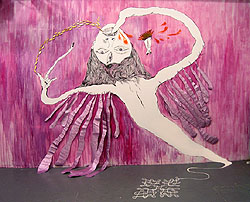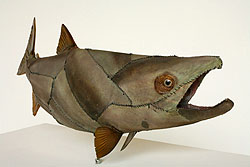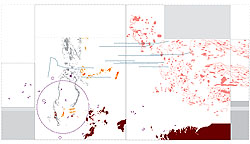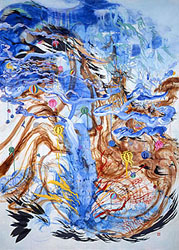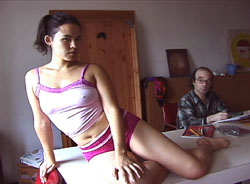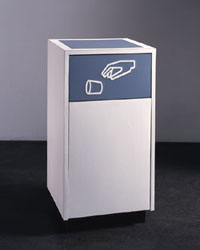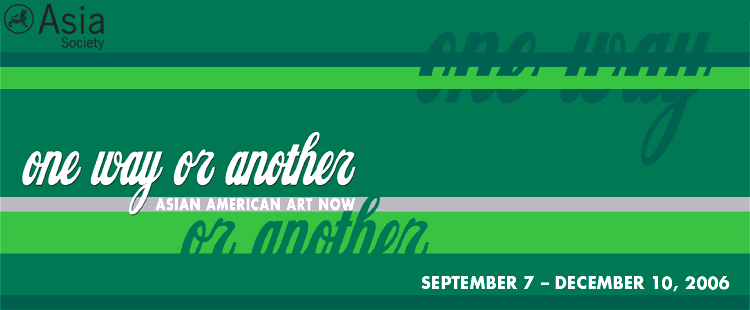 |
ARTISTS IN THE EXHIBITION Michael Arcega | Xavier Cha | Patty Chang | Binh Danh | Mari Eastman | Ala Ebtekar | Chitra Ganesh | Glenn Kaino | Geraldine Lau | Jiha Moon | Laurel Nakadate | Kaz Oshiro | Anna Sew Hoy | Jean Shin | Indigo Som | Mika Tajima | Saira Wasim |
|
Chitra Ganesh’s work incorporates collage, photography, drawing and paint to tell personal and post-colonial narratives that are enacted by characters from Hindu and other religious mythologies. Her use of text, and its dissonance with the painted images, adds another dimension to these epic landscapes of imagined histories. Ganesh is particularly interested in the expression of gender in mythology and in the female body as a metaphoric site of social and individual trauma. In disquieting and often violent ways, she combines real and imagined figures in scenes that transgress time, culture, and faith to confront each other, and their audiences, in provocative illusionary spaces. Excerpt from artist’s statement “I continue to be obsessed by how memories, dreams, and their repression shape personal and social crises, be it between lovers or global empires. My work is largely inspired by Hindu and other mythologies, lyric poetry and song lyrics (both Bollywood and girl rock), the logic of dreams, and present-day imperialism and queer politics. I’m fascinated by how traditional mythology/folklore celebrates sex and violence, but only to instill notions of appropriate behavior and gender expression by punishing those who attempt to transgress societal norms.”
|
|
|
For One Way or Another, Glenn Kaino created a taxidermy installation called Graft. In this work he has swapped the skin of a pig with that of a cow, and the skin of a salmon with that of a shark, producing a patchwork of mismatched colors and textures. The dark sutures in the skin reveal the vulnerability of personal “make overs” and attempts at physical transformation that extend from plastic surgery to race. What does this violent intervention on the most visible site of the animal do to its identity? How can this function as a comment on hybrid human identities that extend beyond simple categorization? In the context of this exhibition, Graft helps to frame some of the overarching concerns of these artists to deconstruct and refine an Asian American sense of self and consider its many meanings. Excerpt from artist’s statement CLAYTON BIGSBY What kind of people is it in which
|
|
|
Geraldine Lau’s vinyl installation produced for One Way or Another is called Information Retrieval #125 (East of India). Lau’s work foregrounds issues of cultural transition and transformation and draws on the imagery of nautical maps. Lau is interested specifically in the historical immigration of two distinct groups to Singapore: Chinese immigrants who traveled through treacherous routes from China through the Straits of Malacca and Malaysia, and the East India Company, which was a British mercantile trade company that brought the first colonial inhabitants to the region. Both types of migratory movements fundamentally altered the cultural landscape of Singapore, though in radically different, and enduring, ways. The placement of this installation in the museum (in the stairwell between the 2 nd and 3 rd floors) parallels Lau’s theme; as visitors “travel” up these stairs and through the exhibition, they are likewise transformed by the experience, and their participation alters the museum’s internal landscape. Excerpt from artist’s statement “The title of this piece, East of India, refers to two related but different ideas in relation to the history of immigration in Singapore, where I grew up. Points east of India are where most early Chinese immigrants who eventually made Singapore their home originate from, often making their way through the Straits of Malacca, and through parts of Malaysia, and finally settling in Singapore. The second tribute is an acknowledgement of the colonial influence in Singapore.”
|
|
|
Play between eastern and western motifs, transcendent pop-culture images, delicate washes, and vibrant graphic accents all merge within the fantastic swirling landscapes of Jiha Moon. These are otherworldly landscapes, existing partly in a cartoonish world of flat candy colors and caricatures, and partly in an ephemeral shifting play between Korean and American visual cues. Moon is intrigued with the intersection of opposites and their residual synergy. If you move closer to the paintings, you can discern her fine and pointed brushwork; when you step back, it is the sweeping washes that come alive with emotion, referencing historical monochromatic landscapes from East Asia. Moon’s choice of motifs creates similar juxtapositions; rainbow stripes, clouds, and dragons seamlessly inhabit the same world as Pac Man or Hello Kitty icons. These new and strange worlds filled with impenetrable flora and fauna seem to suggest narratives that are just beyond our reach and endlessly shifting to evade any conclusions. Excerpt from artist’s statement “As I move through life, living in different places and experiencing various cultures, I imagine places where opposite dreams coexist. I find places that are both peaceful and dangerous, fast and slow, full of old and new.”
|
|
|
Laurel Nakadate’s video installation for One Way or Another is entitled I Want to be the One Who Walks in the Sun. In her performative video narratives, Nakadate assumes the personae of various heroines and incorporates members of the non-artist public into her carefully orchestrated dramas. The actors in Nakadate’s stories are all single, middle-aged men met through chance encounters on the street and solicited to play roles in her films. Their outsider status as strangers helps Nakadate construct unsettling narratives about isolation, loneliness, seduction, and terror. Excerpt from artist’s statement “I am obsessed with men who live alone with no one to care for them. I am always watching them, because they are invisible people in our culture. They don’t have wives or children; they don’t have anyone to go home to. I think about the desire to be saved from loneliness, the way one life can change another. I think about the lies we tell and the lies we are told. I am fascinated with the ways lives intersect, and the ways the larger disasters of the world meet the personal, quiet terrors of an isolated life. I shoot in strangers’ homes because I am obsessed with the things they accumulate and fill their lives with . . . it’s as if they’re packing a ship for a long and lonely ocean voyage.”
|
|
|
By re-creating some of the most banal objects in our environment, such as washing machines, food court trash receptacles and microwave ovens, Kaz Oshiro stretches the conventional limits of painting on both a literal and conceptual level. In elevating the value of these objects, he also forces us to look at them anew, as modular forms and as products of a modernist aesthetic. This association is further complicated by the objects’ traces of their former users. Rock band stickers or spilled detergent interrupt the clean lines and cold formality of these mass-produced boxes with sudden emotions of nostalgia or humor. Should these containers be seen as art or commodity; as the product of a reasoned aesthetic or junk? In his trash-bin-shaped paintings, such as the one in this exhibition, Oshiro adds the disorienting dimension of space to this equation. Visitors are tempted to mistakenly deposit litter into the work and in doing so, become keenly aware of how their perception of the trash bin, and its value in the exhibition, shifts accordingly. Excerpt from artist’s statement “I’m interested in these objects I see that at first irritate, then we ignore. I remember and reformat them by using the painter’s vocabulary. Thus, ideally my objects may be placed in any condition at any place without identification that labels the objects as art. Hopefully, my works transcend the chaotic aspect within our ambience as does environmental noise.”
|
|
| © 2005 Asia Society | 725 Park Avenue at 70th Street NY, NY 10021 | 212-288-6400 | Press Releases | Contact | FAQ | Become a Member
|
